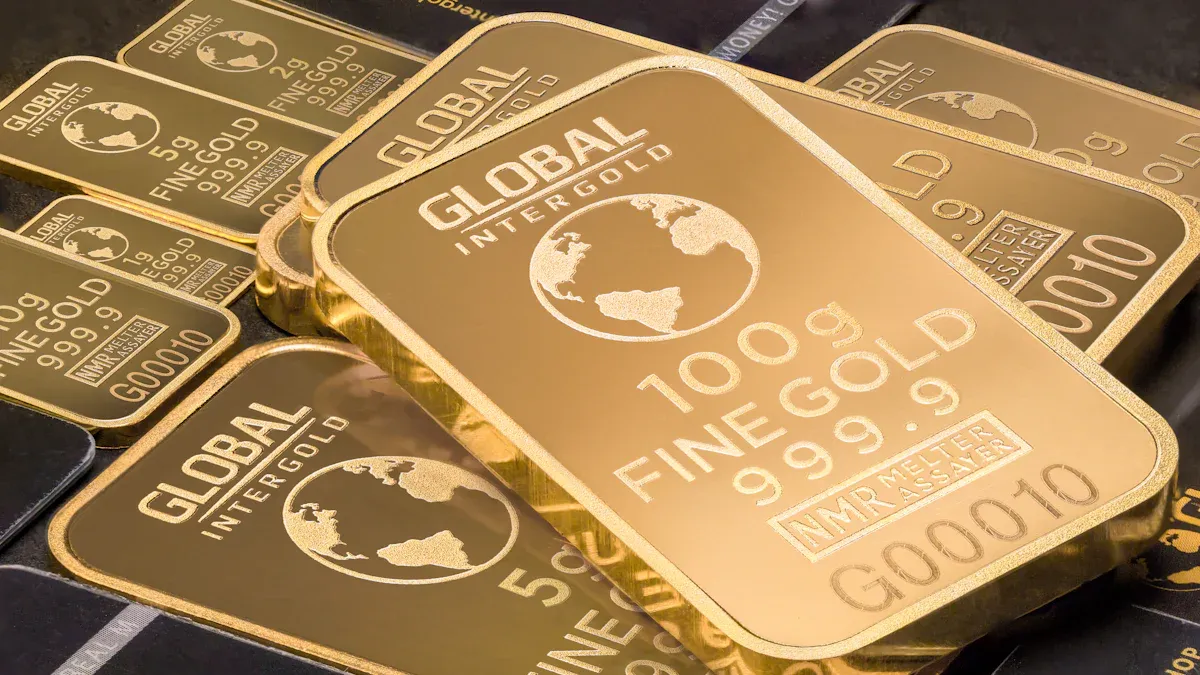Was ist der Unterschied zwischen falschem und künstlichem Gold?
When shopping for jewelry or precious metals, it’s not uncommon to come across terms like “fake Gold” and “Kunstgold.” While they might sound similar, they have distinctly different meanings—especially when you’re making an investment, evaluating pawned goods, or reclaiming precious metals for refining. Understanding the difference between the two helps you make smarter decisions and avoid costly mistakes.

Falsches Gold vs. Kunstgold: What’s the Real Difference?
Falsches Gold refers to a material that is made to intentionally deceive. It’s designed to look like real gold but contains no actual gold content. It may be made from cheap metals such as brass, zinc alloy, or copper and sometimes even plated with a thin layer of gold to appear more convincing. The main purpose of fake gold is to imitate the appearance of real gold, often misleading buyers into believing they are purchasing authentic items.
Faux gold, Auf der anderen Seite, Ist not necessarily meant to deceive. It’s a term used for imitation gold, typically in fashion or costume jewelry, where manufacturers clearly state the product is not made of real gold. Faux gold may include materials like gold-tone metal, gold-plated brass, or resin and plastic with a gold finish. It’s often marketed honestly for aesthetic purposes rather than as an investment.
Zusammenfassend:
- Falsches Gold = counterfeit, deceptive, no real gold.
- Faux gold = imitation, decorative, may include minimal real gold (e.g., vergoldet).
Recognizing this difference is essential for consumers, retailers, pawnshop owners, and precious metal recyclers. Misidentifying a fake item as real gold can lead to financial losses, customer disputes, or legal issues in regulated industries.
Why This Distinction Matters
Understanding whether you’re dealing with fake or faux gold matters for multiple reasons:
- Investment Protection: Gold holds intrinsic value. Buying counterfeit items means you’re investing in a worthless asset.
- Business Accuracy: Jewelers and recyclers must assess authenticity to offer accurate pricing.
- Recycling Efficiency: Misclassifying materials wastes time and effort during the metal reclamation process.
- Reputation Management: Selling fake gold, even unintentionally, can damage customer trust and brand integrity.
Whether you’re buying or testing gold, distinguishing between real, fake, and faux ensures trust, transparency, and compliance with industry standards.
Common Signs of Fake or Faux Gold

While some signs are obvious, others require professional-grade testing:
- Discoloration: Real gold doesn’t tarnish. Black, green, or red discoloration suggests it’s not genuine.
- Magnettest: Gold ist nicht magnetisch. If the item sticks to a magnet, it’s likely fake or gold-plated.
- Stamps & Hallmarks: Authentic gold usually carries purity marks (e.g., 18K, 750). Be cautious—fakes may include counterfeit stamps.
- Gewicht: Gold is denser than most imitation metals. Lighter weight may indicate it’s faux or fake.
- Price Point: “Too good to be true” deals often are.
Jedoch, these basic checks aren’t always conclusive. That’s where professional testing becomes essential.
How to Accurately Test for Real Gold
For complete certainty, especially in commercial environments, accurate testing is critical. Traditional methods like acid tests can damage the item and often don’t offer precise results—especially for thinly gold-plated or mixed materials.
Hier ist der Ort, an dem RFA (Röntgenfluoreszenz) Technologie, like that offered by Vray -Instrumente, becomes the gold standard for non-destructive, high-precision testing.
Vray -Instrumente: Your Partner in Gold Purity Verification
At VRAY Instruments, we specialize in advanced RFA-AnalysatorS designed to test gold purity accurately, efficiently, and without damaging the sample. Our devices are trusted by jewelry professionals, Leihhäuser, Recycler, and refiners who demand fast, Zuverlässige Ergebnisse.
Recommended Devices for Gold Verification:
✅ VR-X5 – Perfect for jewelry stores and gold recyclers. Offers real-time results with a user-friendly interface.
✅ VR-M5 – A Tragbar, batteriebetrieben Handheld analyzer ideal for mobile testing and field use.
✅ VR-T6 – Designed for labs and serious professionals. High-precision readings with a Multi-FP algorithm and large sample chamber.
✅ VR-H5 – Our handheld flagship model, ideal for onsite authenticity checks during trade-ins or customer inspections.
All models deliver Zerstörungsfreie Prüfung, dürfen detect trace elements, and distinguish between real, fake, and faux gold—no guesswork, keine Säure, no risk.
Real-World Scenarios: How Professionals Use VRAY XRF Devices
- Pfandhäuser: Avoid buying fake gold by confirming metal composition in seconds with the VR-H5.
- Juweliergeschäfte: Use the VR-X5 to verify karat value and protect your reputation.
- Hersteller: Ensure consistent product quality with VR-T6 during gold plating checks.
- Precious Metal Recyclers: The VR-M5 helps identify value in mixed lots and increase recovery rates.
By implementing VRAY’s XRF technology, users streamline operations, boost trust, and maximize ROI.
Conclusion
While both fake and faux gold may lack significant value, their intent, use, Und implications differ dramatically. Fake gold is crafted to deceive, while faux gold is typically a disclosed imitation used in fashion jewelry. For anyone in the gold trade—whether you’re a buyer, seller, or tester—knowing the difference and using the right tools is essential.
Don’t rely on visual inspections or outdated testing methods. Invest in VRAY Instruments’ RFA SpektrometerS to ensure every piece of gold you handle is accurately analyzed, ethically sourced, and profitably evaluated.
Häufig gestellte Fragen
Q1:How can I tell if my gold is real without damaging it?
A1:Use a non-destructive XRF analyzer like VRAY’s VR-H5 or VR-X5. These tools scan the item and instantly reveal its composition without harm.
Q2:Is gold-plated jewelry considered fake or faux gold?
A2:Gold-plated jewelry is generally considered Kunstgold if sold honestly. Jedoch, if it’s passed off as solid gold, it becomes fake Gold.
Q3:Are acid tests still reliable for gold testing?
A3:Acid tests can be useful but are less precise and may damage the item. They also cannot detect layered or mixed materials effectively like an XRF device can.

WhatsApp
Scannen Sie den QR-Code, um einen WhatsApp-Chat mit uns zu starten.